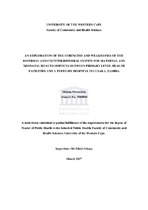| dc.description.abstract | Introduction: Despite the progress that Zambia has made in reducing its maternal mortality ratio from 649 to 398 per 100,000 live births between 1996 and 2013/14, the country did not meet the Millennium Development Goal 5a target, of reducing the maternal mortality ratio by 75% (i.e. to a ratio of 162 per 100,000 live births) by the end of 2015. Thus, as is the case with many other countries, considerable challenges still remain in relation to reducing maternal mortality in Zambia.
According to Zambia's Roadmap for Accelerating Reduction of Maternal, Newborn and Child Mortality (2013-2016), the continuum of care for reproductive and maternal, newborn, and child health includes integrated service delivery for mothers and children across these various time periods, and also across place: within the home, the community, and in health facilities. In this regard, a referral system plays a key role in linking the various levels at which care is provided, and the different types of services offered at these levels. In the urban district of Lusaka, Zambia, all complicated pregnancy-related cases received by health centres or clinics are referred to either Levy Mwanawasa General Hospital, or the
University Teaching Hospital. However, it appears that at present those working at the primary level of care, who make such referrals up to these higher levels of care, receive no feedback on the outcome of their referrals; there are also few counter-referrals to the respective clinics in the district. With limited communication to the primary level of care, and with no formal handover of patients back to the clinics by the tertiary level institutions, it is difficult to ensure that the required continuum of care for the referred mothers and their children, post-delivery, has been established within the district. This explorative study aimed therefore to identify the strengths and weaknesses of the maternity-related referral system currently operating between primary and tertiary levels of health care in the district, and to consider how the system might be strengthened so as to support a stronger continuum of care with respect to maternal and neonatal health. Methods: Using a descriptive qualitative research approach, stakeholders involved in the planning,
delivery and/or oversight of maternal and neonatal health services in the district were purposively sampled and asked to voluntarily participate in the study. Prior to all the interviews, after being informed about the study, and receiving information sheets to read through, participants were required to give informed consent. Their experiences and opinions regarding referrals and counter-referrals were collected through a series of 23 individual, semi-structured interviews. A Thematic Analysis approach was used to analyse data in this study. Ethics approval was first obtained from the Senate Research Committee, University of the Western Cape and thereafter from the Excellence in Research Ethics and Science Converge Ethical Review Board in Zambia, before proceeding with the study. Clearance was also
obtained from the Ministry of Health, the Lusaka District Health Management Team and the University Teaching Hospital to facilitate entry into the health facilities.
Findings: The study found that, in practice, the referral system for maternity and neonatal health does exist and is generally – but not optimally - functional in the Lusaka District. However, challenges were noted that included the fact that the district’s maternity referral system has not been revised since it was first developed in the 1980s and is not available in a comprehensive set of guidelines or standard operational procedures which explicitly outline the reasons for referral and the related referral steps and mechanisms. In addition, the referral forms currently
in use in the district have not been standardised and appear to be inconsistently used by the different facilities. Interviewees reported that there were limitations in terms of the number of, and availability of ambulances, and that there was also an inadequate number of trained midwives. Limitations on the health service's infrastructure, namely, the physical space that is available, the number of delivery beds, and the limited supply of equipment place an additional burden on the staff working at both the primary and tertiary level. Conclusion: Overall, the study recommends that further research – possibly in the form of a baseline audit – be conducted so as to develop a more detailed and/or operational assessment of the actual rather than the reported level of functionality of the district's maternity referral system. Specific recommendations are also proposed for the various stakeholders who are critical role players in the referral system, namely, the clinics, the University Teaching Hospital, the Lusaka District Health Management Team, the Provincial Health Office, the Ministry of Health and Cooperating Partners. | en_US |

